Strategic Human Resource Management at Sainsbury: Report
VerifiedAdded on 2020/01/15
|18
|6485
|225
Report
AI Summary
This report examines the strategic Human Resource Management (HRM) practices at Sainsbury, a major UK supermarket chain. It begins by defining HRM and comparing Storey's definition with personnel and Industrial Relations (IR) practices. The report then analyzes the Guest model of HRM, its application at Sainsbury, and the implications of a strategic HRM approach for line managers and employees. It further explores the core and periphery workforce model, detailing various types of flexibility like numerical, functional, and financial. The report discusses specific flexible working practices implemented by Sainsbury, including part-time and temporary staff, teleworking, and zero-hour contracts. It also addresses the impact of changes in the labor market on flexible working practices. The analysis includes a comparison of HRM approaches, the roles of line managers, and the impact on employee motivation and development, providing insights into Sainsbury's workforce management strategies and their effectiveness. The report underscores the importance of employee training, communication, and the creation of a flexible work environment to achieve organizational goals.
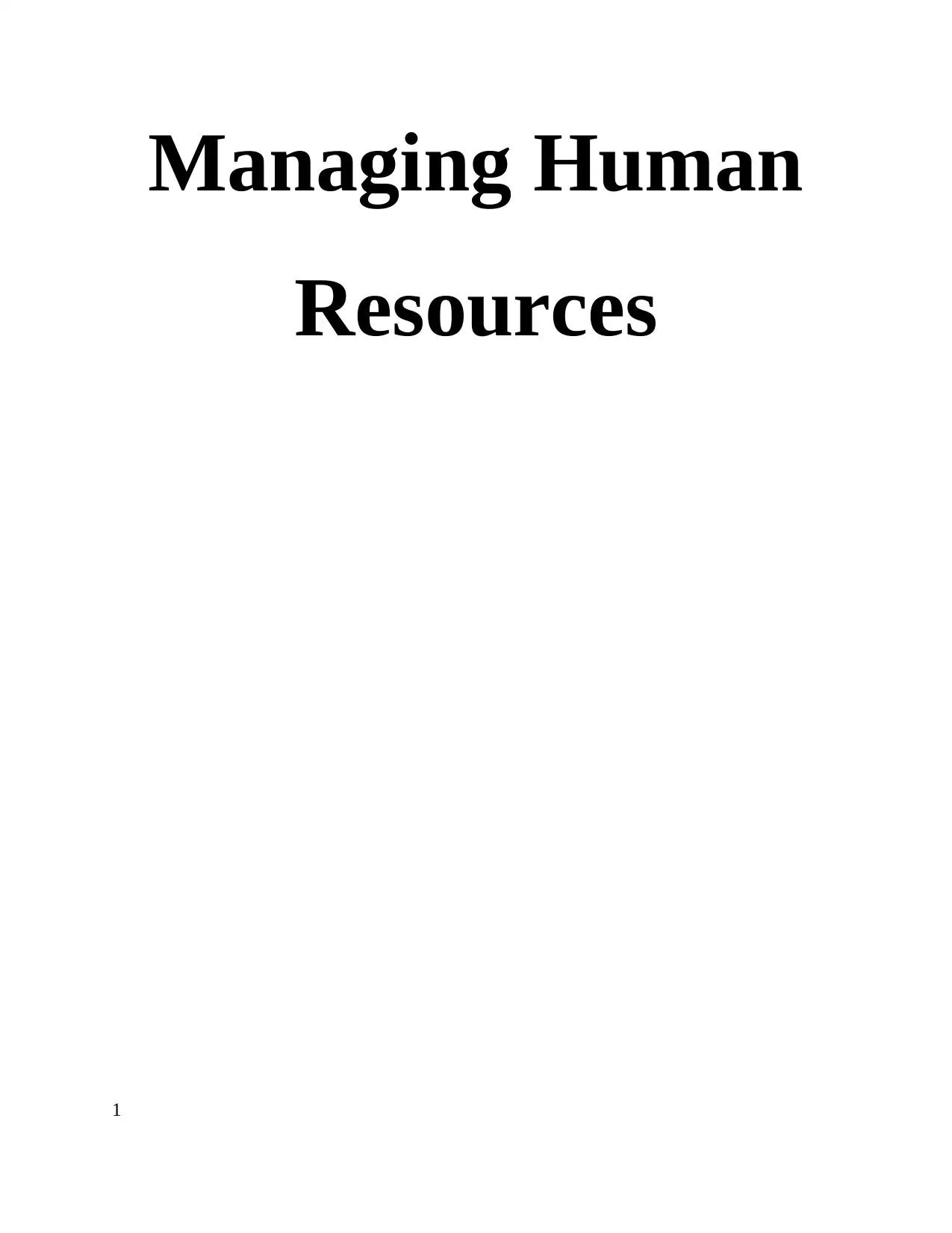
Managing Human
Resources
1
Resources
1
Paraphrase This Document
Need a fresh take? Get an instant paraphrase of this document with our AI Paraphraser
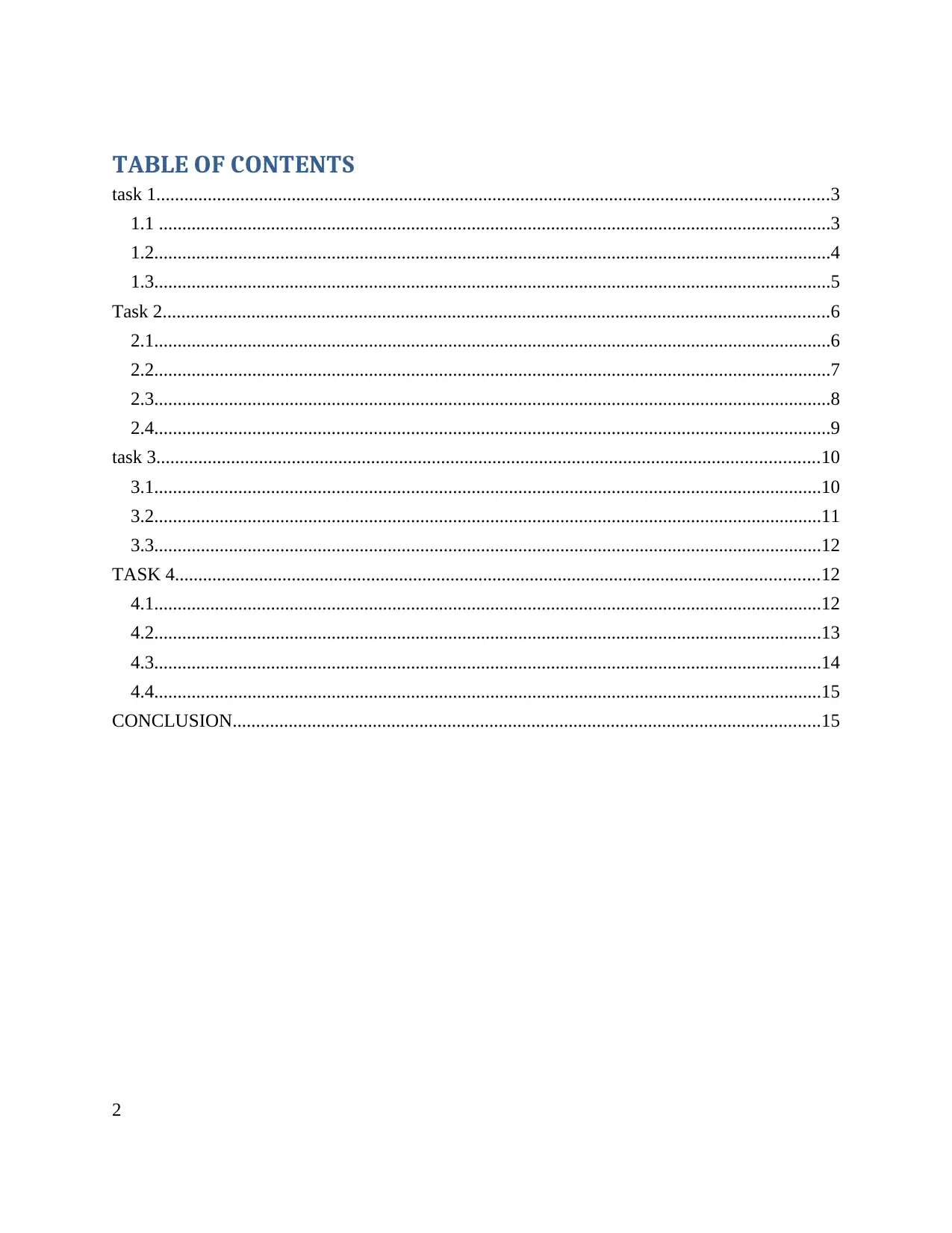
TABLE OF CONTENTS
task 1................................................................................................................................................3
1.1 ................................................................................................................................................3
1.2.................................................................................................................................................4
1.3.................................................................................................................................................5
Task 2...............................................................................................................................................6
2.1.................................................................................................................................................6
2.2.................................................................................................................................................7
2.3.................................................................................................................................................8
2.4.................................................................................................................................................9
task 3..............................................................................................................................................10
3.1...............................................................................................................................................10
3.2...............................................................................................................................................11
3.3...............................................................................................................................................12
TASK 4..........................................................................................................................................12
4.1...............................................................................................................................................12
4.2...............................................................................................................................................13
4.3...............................................................................................................................................14
4.4...............................................................................................................................................15
CONCLUSION..............................................................................................................................15
2
task 1................................................................................................................................................3
1.1 ................................................................................................................................................3
1.2.................................................................................................................................................4
1.3.................................................................................................................................................5
Task 2...............................................................................................................................................6
2.1.................................................................................................................................................6
2.2.................................................................................................................................................7
2.3.................................................................................................................................................8
2.4.................................................................................................................................................9
task 3..............................................................................................................................................10
3.1...............................................................................................................................................10
3.2...............................................................................................................................................11
3.3...............................................................................................................................................12
TASK 4..........................................................................................................................................12
4.1...............................................................................................................................................12
4.2...............................................................................................................................................13
4.3...............................................................................................................................................14
4.4...............................................................................................................................................15
CONCLUSION..............................................................................................................................15
2
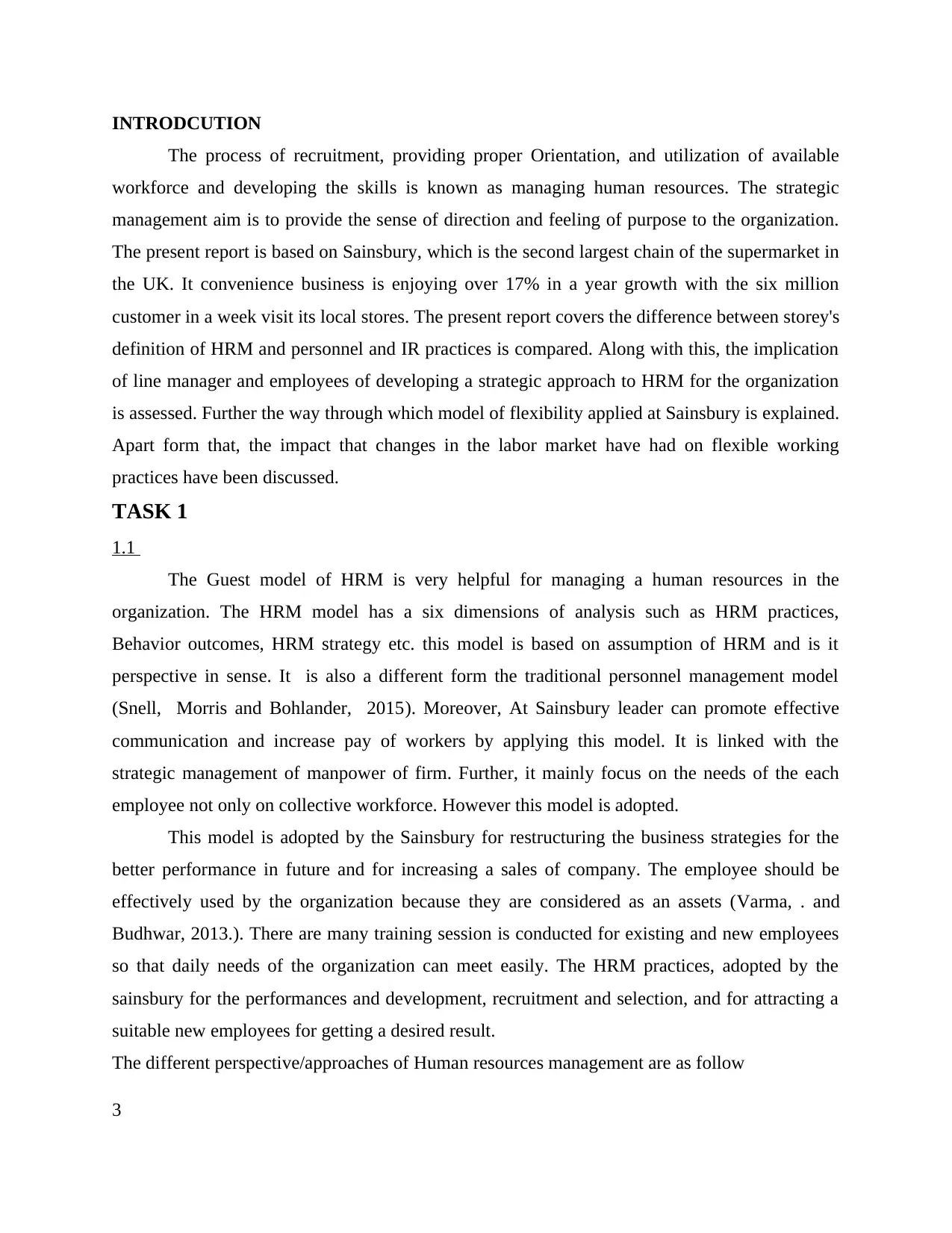
INTRODCUTION
The process of recruitment, providing proper Orientation, and utilization of available
workforce and developing the skills is known as managing human resources. The strategic
management aim is to provide the sense of direction and feeling of purpose to the organization.
The present report is based on Sainsbury, which is the second largest chain of the supermarket in
the UK. It convenience business is enjoying over 17% in a year growth with the six million
customer in a week visit its local stores. The present report covers the difference between storey's
definition of HRM and personnel and IR practices is compared. Along with this, the implication
of line manager and employees of developing a strategic approach to HRM for the organization
is assessed. Further the way through which model of flexibility applied at Sainsbury is explained.
Apart form that, the impact that changes in the labor market have had on flexible working
practices have been discussed.
TASK 1
1.1
The Guest model of HRM is very helpful for managing a human resources in the
organization. The HRM model has a six dimensions of analysis such as HRM practices,
Behavior outcomes, HRM strategy etc. this model is based on assumption of HRM and is it
perspective in sense. It is also a different form the traditional personnel management model
(Snell, Morris and Bohlander, 2015). Moreover, At Sainsbury leader can promote effective
communication and increase pay of workers by applying this model. It is linked with the
strategic management of manpower of firm. Further, it mainly focus on the needs of the each
employee not only on collective workforce. However this model is adopted.
This model is adopted by the Sainsbury for restructuring the business strategies for the
better performance in future and for increasing a sales of company. The employee should be
effectively used by the organization because they are considered as an assets (Varma, . and
Budhwar, 2013.). There are many training session is conducted for existing and new employees
so that daily needs of the organization can meet easily. The HRM practices, adopted by the
sainsbury for the performances and development, recruitment and selection, and for attracting a
suitable new employees for getting a desired result.
The different perspective/approaches of Human resources management are as follow
3
The process of recruitment, providing proper Orientation, and utilization of available
workforce and developing the skills is known as managing human resources. The strategic
management aim is to provide the sense of direction and feeling of purpose to the organization.
The present report is based on Sainsbury, which is the second largest chain of the supermarket in
the UK. It convenience business is enjoying over 17% in a year growth with the six million
customer in a week visit its local stores. The present report covers the difference between storey's
definition of HRM and personnel and IR practices is compared. Along with this, the implication
of line manager and employees of developing a strategic approach to HRM for the organization
is assessed. Further the way through which model of flexibility applied at Sainsbury is explained.
Apart form that, the impact that changes in the labor market have had on flexible working
practices have been discussed.
TASK 1
1.1
The Guest model of HRM is very helpful for managing a human resources in the
organization. The HRM model has a six dimensions of analysis such as HRM practices,
Behavior outcomes, HRM strategy etc. this model is based on assumption of HRM and is it
perspective in sense. It is also a different form the traditional personnel management model
(Snell, Morris and Bohlander, 2015). Moreover, At Sainsbury leader can promote effective
communication and increase pay of workers by applying this model. It is linked with the
strategic management of manpower of firm. Further, it mainly focus on the needs of the each
employee not only on collective workforce. However this model is adopted.
This model is adopted by the Sainsbury for restructuring the business strategies for the
better performance in future and for increasing a sales of company. The employee should be
effectively used by the organization because they are considered as an assets (Varma, . and
Budhwar, 2013.). There are many training session is conducted for existing and new employees
so that daily needs of the organization can meet easily. The HRM practices, adopted by the
sainsbury for the performances and development, recruitment and selection, and for attracting a
suitable new employees for getting a desired result.
The different perspective/approaches of Human resources management are as follow
3
⊘ This is a preview!⊘
Do you want full access?
Subscribe today to unlock all pages.

Trusted by 1+ million students worldwide
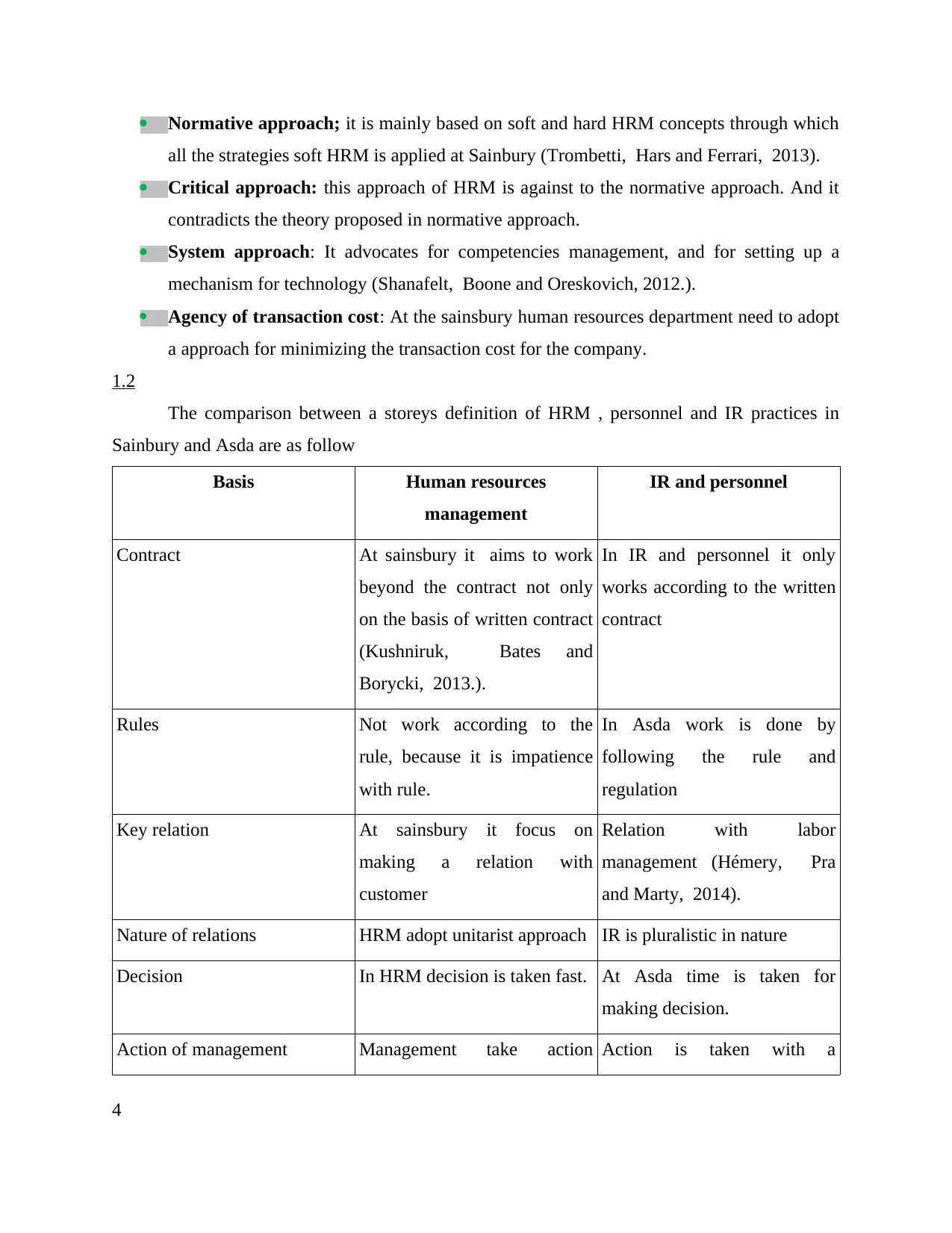
Normative approach; it is mainly based on soft and hard HRM concepts through which
all the strategies soft HRM is applied at Sainbury (Trombetti, Hars and Ferrari, 2013).
Critical approach: this approach of HRM is against to the normative approach. And it
contradicts the theory proposed in normative approach.
System approach: It advocates for competencies management, and for setting up a
mechanism for technology (Shanafelt, Boone and Oreskovich, 2012.).
Agency of transaction cost: At the sainsbury human resources department need to adopt
a approach for minimizing the transaction cost for the company.
1.2
The comparison between a storeys definition of HRM , personnel and IR practices in
Sainbury and Asda are as follow
Basis Human resources
management
IR and personnel
Contract At sainsbury it aims to work
beyond the contract not only
on the basis of written contract
(Kushniruk, Bates and
Borycki, 2013.).
In IR and personnel it only
works according to the written
contract
Rules Not work according to the
rule, because it is impatience
with rule.
In Asda work is done by
following the rule and
regulation
Key relation At sainsbury it focus on
making a relation with
customer
Relation with labor
management (Hémery, Pra
and Marty, 2014).
Nature of relations HRM adopt unitarist approach IR is pluralistic in nature
Decision In HRM decision is taken fast. At Asda time is taken for
making decision.
Action of management Management take action Action is taken with a
4
all the strategies soft HRM is applied at Sainbury (Trombetti, Hars and Ferrari, 2013).
Critical approach: this approach of HRM is against to the normative approach. And it
contradicts the theory proposed in normative approach.
System approach: It advocates for competencies management, and for setting up a
mechanism for technology (Shanafelt, Boone and Oreskovich, 2012.).
Agency of transaction cost: At the sainsbury human resources department need to adopt
a approach for minimizing the transaction cost for the company.
1.2
The comparison between a storeys definition of HRM , personnel and IR practices in
Sainbury and Asda are as follow
Basis Human resources
management
IR and personnel
Contract At sainsbury it aims to work
beyond the contract not only
on the basis of written contract
(Kushniruk, Bates and
Borycki, 2013.).
In IR and personnel it only
works according to the written
contract
Rules Not work according to the
rule, because it is impatience
with rule.
In Asda work is done by
following the rule and
regulation
Key relation At sainsbury it focus on
making a relation with
customer
Relation with labor
management (Hémery, Pra
and Marty, 2014).
Nature of relations HRM adopt unitarist approach IR is pluralistic in nature
Decision In HRM decision is taken fast. At Asda time is taken for
making decision.
Action of management Management take action Action is taken with a
4
Paraphrase This Document
Need a fresh take? Get an instant paraphrase of this document with our AI Paraphraser
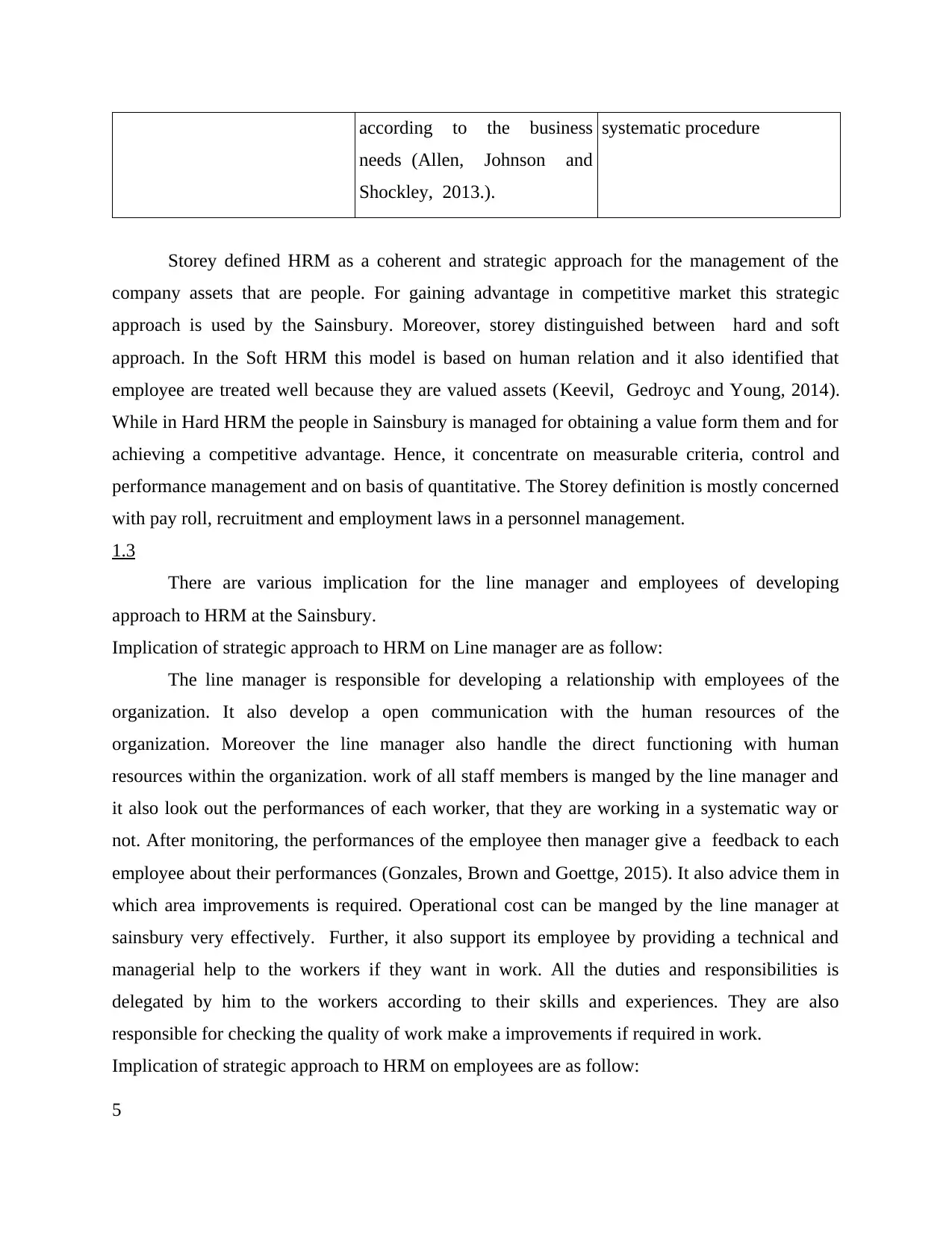
according to the business
needs (Allen, Johnson and
Shockley, 2013.).
systematic procedure
Storey defined HRM as a coherent and strategic approach for the management of the
company assets that are people. For gaining advantage in competitive market this strategic
approach is used by the Sainsbury. Moreover, storey distinguished between hard and soft
approach. In the Soft HRM this model is based on human relation and it also identified that
employee are treated well because they are valued assets (Keevil, Gedroyc and Young, 2014).
While in Hard HRM the people in Sainsbury is managed for obtaining a value form them and for
achieving a competitive advantage. Hence, it concentrate on measurable criteria, control and
performance management and on basis of quantitative. The Storey definition is mostly concerned
with pay roll, recruitment and employment laws in a personnel management.
1.3
There are various implication for the line manager and employees of developing
approach to HRM at the Sainsbury.
Implication of strategic approach to HRM on Line manager are as follow:
The line manager is responsible for developing a relationship with employees of the
organization. It also develop a open communication with the human resources of the
organization. Moreover the line manager also handle the direct functioning with human
resources within the organization. work of all staff members is manged by the line manager and
it also look out the performances of each worker, that they are working in a systematic way or
not. After monitoring, the performances of the employee then manager give a feedback to each
employee about their performances (Gonzales, Brown and Goettge, 2015). It also advice them in
which area improvements is required. Operational cost can be manged by the line manager at
sainsbury very effectively. Further, it also support its employee by providing a technical and
managerial help to the workers if they want in work. All the duties and responsibilities is
delegated by him to the workers according to their skills and experiences. They are also
responsible for checking the quality of work make a improvements if required in work.
Implication of strategic approach to HRM on employees are as follow:
5
needs (Allen, Johnson and
Shockley, 2013.).
systematic procedure
Storey defined HRM as a coherent and strategic approach for the management of the
company assets that are people. For gaining advantage in competitive market this strategic
approach is used by the Sainsbury. Moreover, storey distinguished between hard and soft
approach. In the Soft HRM this model is based on human relation and it also identified that
employee are treated well because they are valued assets (Keevil, Gedroyc and Young, 2014).
While in Hard HRM the people in Sainsbury is managed for obtaining a value form them and for
achieving a competitive advantage. Hence, it concentrate on measurable criteria, control and
performance management and on basis of quantitative. The Storey definition is mostly concerned
with pay roll, recruitment and employment laws in a personnel management.
1.3
There are various implication for the line manager and employees of developing
approach to HRM at the Sainsbury.
Implication of strategic approach to HRM on Line manager are as follow:
The line manager is responsible for developing a relationship with employees of the
organization. It also develop a open communication with the human resources of the
organization. Moreover the line manager also handle the direct functioning with human
resources within the organization. work of all staff members is manged by the line manager and
it also look out the performances of each worker, that they are working in a systematic way or
not. After monitoring, the performances of the employee then manager give a feedback to each
employee about their performances (Gonzales, Brown and Goettge, 2015). It also advice them in
which area improvements is required. Operational cost can be manged by the line manager at
sainsbury very effectively. Further, it also support its employee by providing a technical and
managerial help to the workers if they want in work. All the duties and responsibilities is
delegated by him to the workers according to their skills and experiences. They are also
responsible for checking the quality of work make a improvements if required in work.
Implication of strategic approach to HRM on employees are as follow:
5
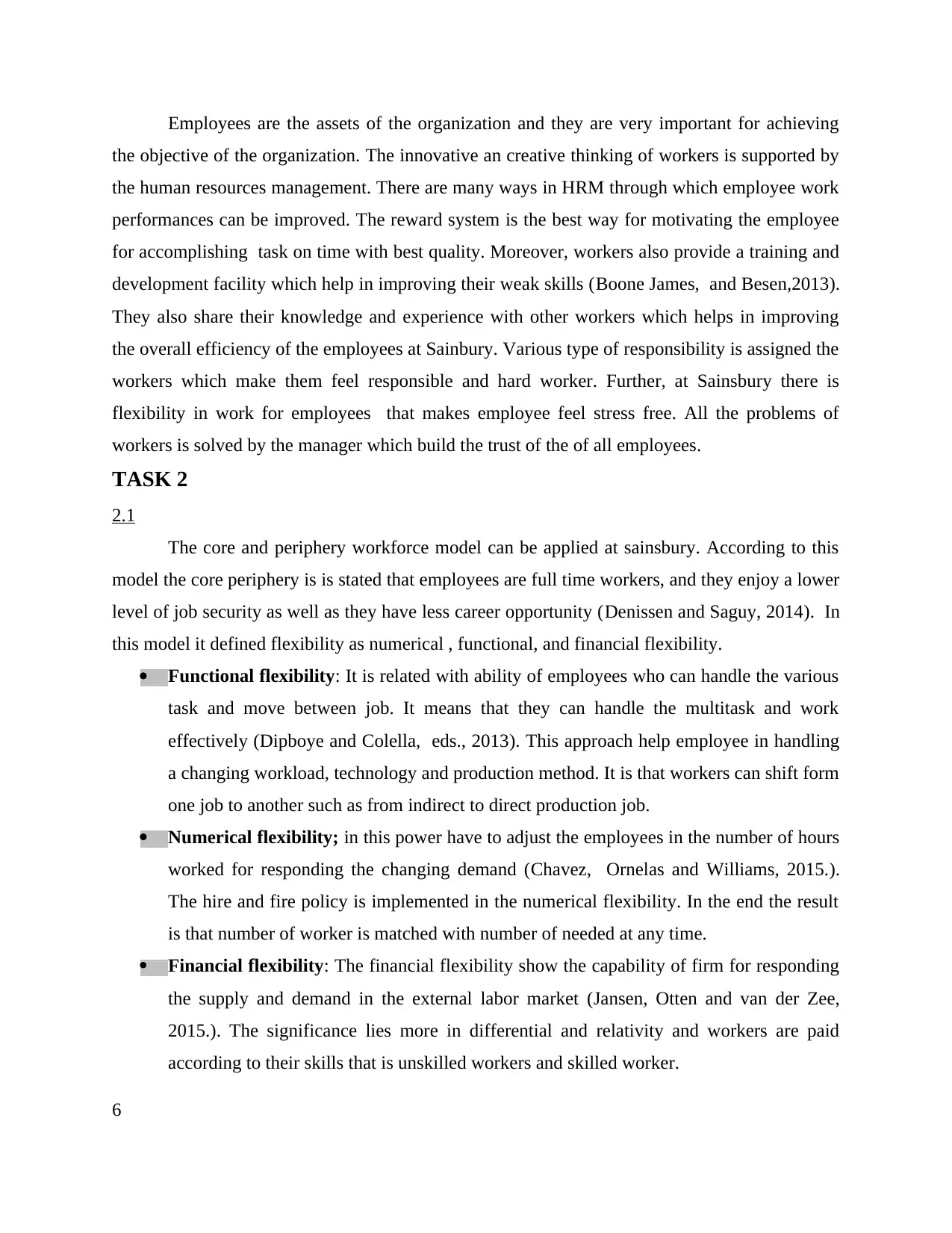
Employees are the assets of the organization and they are very important for achieving
the objective of the organization. The innovative an creative thinking of workers is supported by
the human resources management. There are many ways in HRM through which employee work
performances can be improved. The reward system is the best way for motivating the employee
for accomplishing task on time with best quality. Moreover, workers also provide a training and
development facility which help in improving their weak skills (Boone James, and Besen,2013).
They also share their knowledge and experience with other workers which helps in improving
the overall efficiency of the employees at Sainbury. Various type of responsibility is assigned the
workers which make them feel responsible and hard worker. Further, at Sainsbury there is
flexibility in work for employees that makes employee feel stress free. All the problems of
workers is solved by the manager which build the trust of the of all employees.
TASK 2
2.1
The core and periphery workforce model can be applied at sainsbury. According to this
model the core periphery is is stated that employees are full time workers, and they enjoy a lower
level of job security as well as they have less career opportunity (Denissen and Saguy, 2014). In
this model it defined flexibility as numerical , functional, and financial flexibility.
Functional flexibility: It is related with ability of employees who can handle the various
task and move between job. It means that they can handle the multitask and work
effectively (Dipboye and Colella, eds., 2013). This approach help employee in handling
a changing workload, technology and production method. It is that workers can shift form
one job to another such as from indirect to direct production job.
Numerical flexibility; in this power have to adjust the employees in the number of hours
worked for responding the changing demand (Chavez, Ornelas and Williams, 2015.).
The hire and fire policy is implemented in the numerical flexibility. In the end the result
is that number of worker is matched with number of needed at any time.
Financial flexibility: The financial flexibility show the capability of firm for responding
the supply and demand in the external labor market (Jansen, Otten and van der Zee,
2015.). The significance lies more in differential and relativity and workers are paid
according to their skills that is unskilled workers and skilled worker.
6
the objective of the organization. The innovative an creative thinking of workers is supported by
the human resources management. There are many ways in HRM through which employee work
performances can be improved. The reward system is the best way for motivating the employee
for accomplishing task on time with best quality. Moreover, workers also provide a training and
development facility which help in improving their weak skills (Boone James, and Besen,2013).
They also share their knowledge and experience with other workers which helps in improving
the overall efficiency of the employees at Sainbury. Various type of responsibility is assigned the
workers which make them feel responsible and hard worker. Further, at Sainsbury there is
flexibility in work for employees that makes employee feel stress free. All the problems of
workers is solved by the manager which build the trust of the of all employees.
TASK 2
2.1
The core and periphery workforce model can be applied at sainsbury. According to this
model the core periphery is is stated that employees are full time workers, and they enjoy a lower
level of job security as well as they have less career opportunity (Denissen and Saguy, 2014). In
this model it defined flexibility as numerical , functional, and financial flexibility.
Functional flexibility: It is related with ability of employees who can handle the various
task and move between job. It means that they can handle the multitask and work
effectively (Dipboye and Colella, eds., 2013). This approach help employee in handling
a changing workload, technology and production method. It is that workers can shift form
one job to another such as from indirect to direct production job.
Numerical flexibility; in this power have to adjust the employees in the number of hours
worked for responding the changing demand (Chavez, Ornelas and Williams, 2015.).
The hire and fire policy is implemented in the numerical flexibility. In the end the result
is that number of worker is matched with number of needed at any time.
Financial flexibility: The financial flexibility show the capability of firm for responding
the supply and demand in the external labor market (Jansen, Otten and van der Zee,
2015.). The significance lies more in differential and relativity and workers are paid
according to their skills that is unskilled workers and skilled worker.
6
⊘ This is a preview!⊘
Do you want full access?
Subscribe today to unlock all pages.

Trusted by 1+ million students worldwide
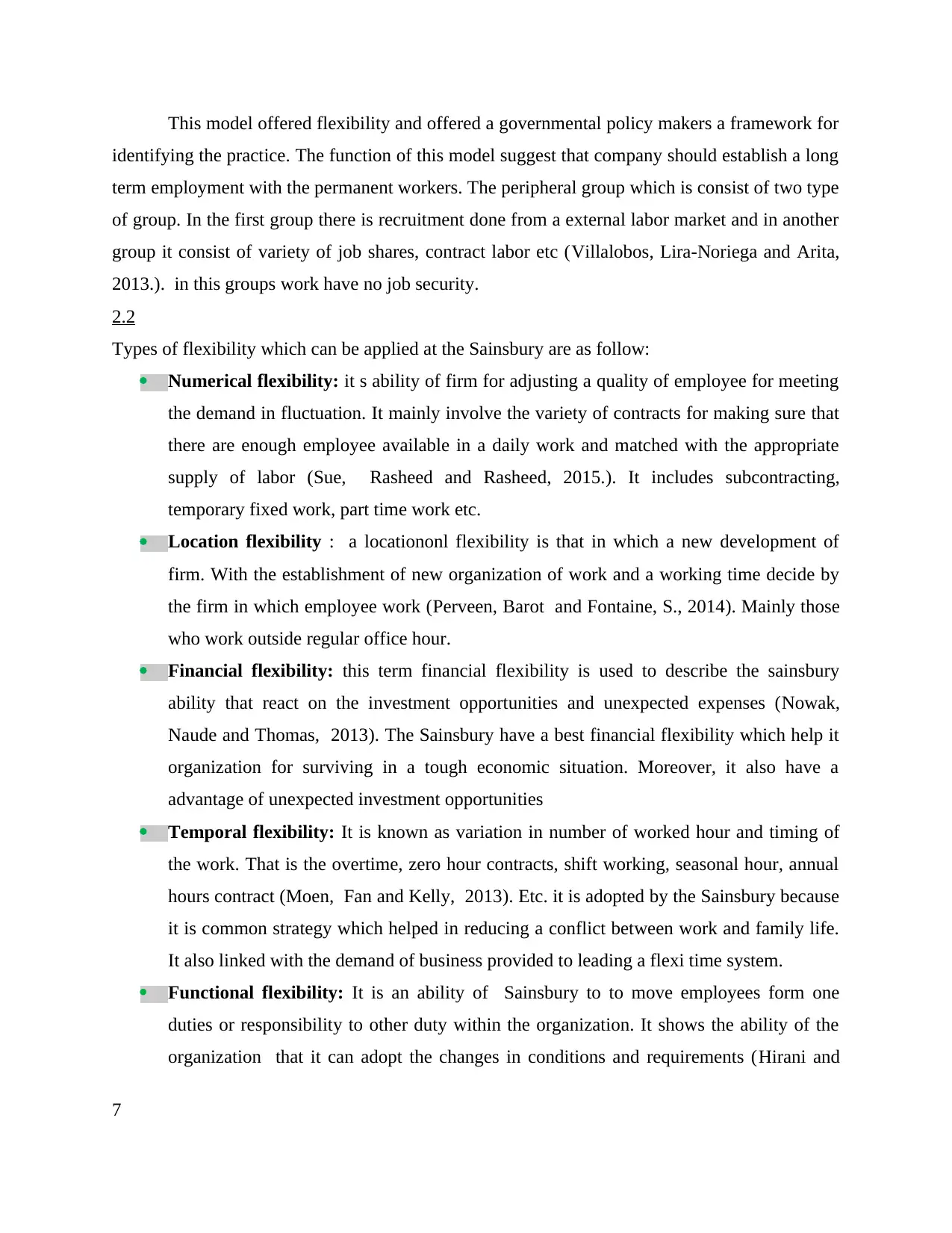
This model offered flexibility and offered a governmental policy makers a framework for
identifying the practice. The function of this model suggest that company should establish a long
term employment with the permanent workers. The peripheral group which is consist of two type
of group. In the first group there is recruitment done from a external labor market and in another
group it consist of variety of job shares, contract labor etc (Villalobos, Lira-Noriega and Arita,
2013.). in this groups work have no job security.
2.2
Types of flexibility which can be applied at the Sainsbury are as follow:
Numerical flexibility: it s ability of firm for adjusting a quality of employee for meeting
the demand in fluctuation. It mainly involve the variety of contracts for making sure that
there are enough employee available in a daily work and matched with the appropriate
supply of labor (Sue, Rasheed and Rasheed, 2015.). It includes subcontracting,
temporary fixed work, part time work etc.
Location flexibility : a locationonl flexibility is that in which a new development of
firm. With the establishment of new organization of work and a working time decide by
the firm in which employee work (Perveen, Barot and Fontaine, S., 2014). Mainly those
who work outside regular office hour.
Financial flexibility: this term financial flexibility is used to describe the sainsbury
ability that react on the investment opportunities and unexpected expenses (Nowak,
Naude and Thomas, 2013). The Sainsbury have a best financial flexibility which help it
organization for surviving in a tough economic situation. Moreover, it also have a
advantage of unexpected investment opportunities
Temporal flexibility: It is known as variation in number of worked hour and timing of
the work. That is the overtime, zero hour contracts, shift working, seasonal hour, annual
hours contract (Moen, Fan and Kelly, 2013). Etc. it is adopted by the Sainsbury because
it is common strategy which helped in reducing a conflict between work and family life.
It also linked with the demand of business provided to leading a flexi time system.
Functional flexibility: It is an ability of Sainsbury to to move employees form one
duties or responsibility to other duty within the organization. It shows the ability of the
organization that it can adopt the changes in conditions and requirements (Hirani and
7
identifying the practice. The function of this model suggest that company should establish a long
term employment with the permanent workers. The peripheral group which is consist of two type
of group. In the first group there is recruitment done from a external labor market and in another
group it consist of variety of job shares, contract labor etc (Villalobos, Lira-Noriega and Arita,
2013.). in this groups work have no job security.
2.2
Types of flexibility which can be applied at the Sainsbury are as follow:
Numerical flexibility: it s ability of firm for adjusting a quality of employee for meeting
the demand in fluctuation. It mainly involve the variety of contracts for making sure that
there are enough employee available in a daily work and matched with the appropriate
supply of labor (Sue, Rasheed and Rasheed, 2015.). It includes subcontracting,
temporary fixed work, part time work etc.
Location flexibility : a locationonl flexibility is that in which a new development of
firm. With the establishment of new organization of work and a working time decide by
the firm in which employee work (Perveen, Barot and Fontaine, S., 2014). Mainly those
who work outside regular office hour.
Financial flexibility: this term financial flexibility is used to describe the sainsbury
ability that react on the investment opportunities and unexpected expenses (Nowak,
Naude and Thomas, 2013). The Sainsbury have a best financial flexibility which help it
organization for surviving in a tough economic situation. Moreover, it also have a
advantage of unexpected investment opportunities
Temporal flexibility: It is known as variation in number of worked hour and timing of
the work. That is the overtime, zero hour contracts, shift working, seasonal hour, annual
hours contract (Moen, Fan and Kelly, 2013). Etc. it is adopted by the Sainsbury because
it is common strategy which helped in reducing a conflict between work and family life.
It also linked with the demand of business provided to leading a flexi time system.
Functional flexibility: It is an ability of Sainsbury to to move employees form one
duties or responsibility to other duty within the organization. It shows the ability of the
organization that it can adopt the changes in conditions and requirements (Hirani and
7
Paraphrase This Document
Need a fresh take? Get an instant paraphrase of this document with our AI Paraphraser
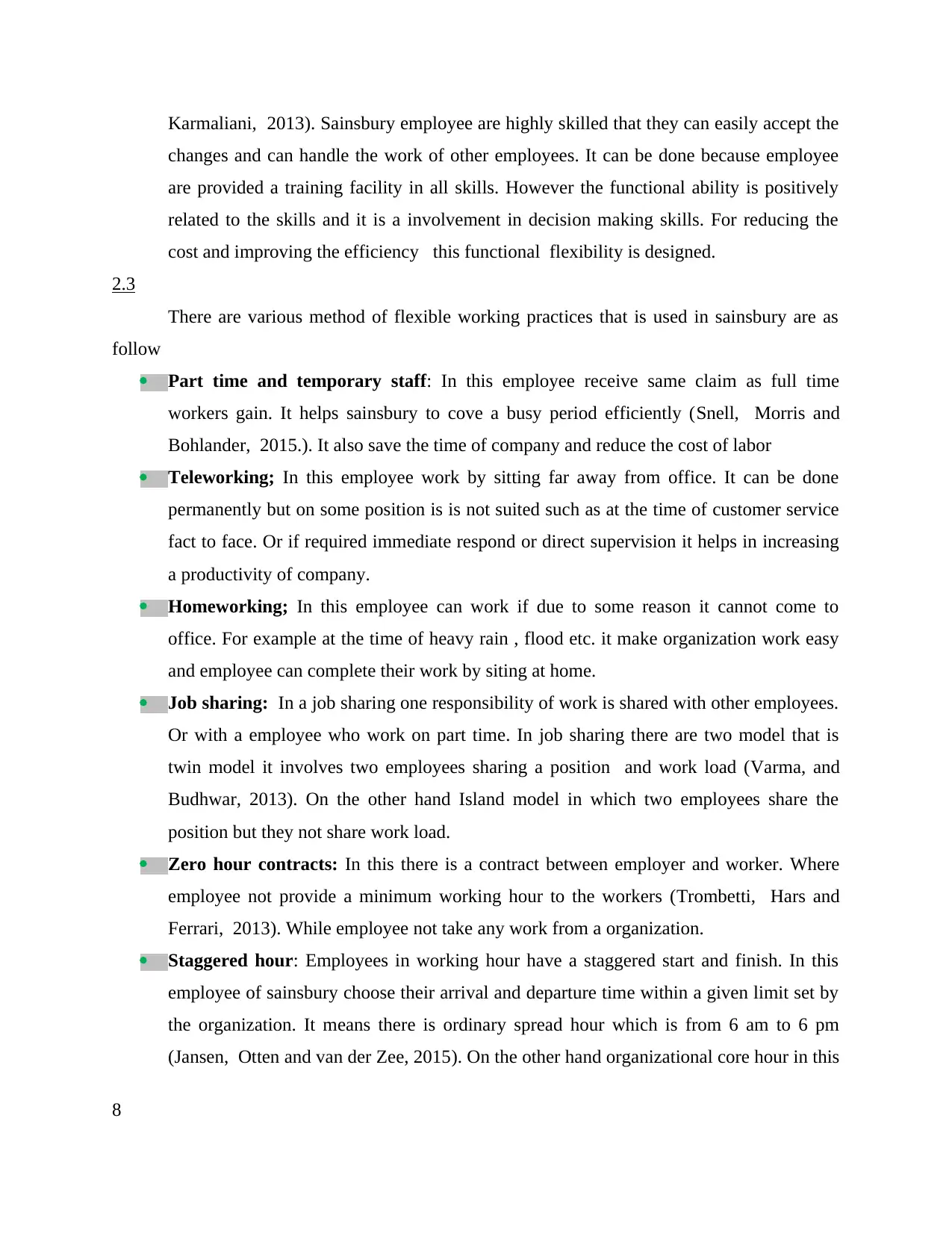
Karmaliani, 2013). Sainsbury employee are highly skilled that they can easily accept the
changes and can handle the work of other employees. It can be done because employee
are provided a training facility in all skills. However the functional ability is positively
related to the skills and it is a involvement in decision making skills. For reducing the
cost and improving the efficiency this functional flexibility is designed.
2.3
There are various method of flexible working practices that is used in sainsbury are as
follow
Part time and temporary staff: In this employee receive same claim as full time
workers gain. It helps sainsbury to cove a busy period efficiently (Snell, Morris and
Bohlander, 2015.). It also save the time of company and reduce the cost of labor
Teleworking; In this employee work by sitting far away from office. It can be done
permanently but on some position is is not suited such as at the time of customer service
fact to face. Or if required immediate respond or direct supervision it helps in increasing
a productivity of company.
Homeworking; In this employee can work if due to some reason it cannot come to
office. For example at the time of heavy rain , flood etc. it make organization work easy
and employee can complete their work by siting at home.
Job sharing: In a job sharing one responsibility of work is shared with other employees.
Or with a employee who work on part time. In job sharing there are two model that is
twin model it involves two employees sharing a position and work load (Varma, and
Budhwar, 2013). On the other hand Island model in which two employees share the
position but they not share work load.
Zero hour contracts: In this there is a contract between employer and worker. Where
employee not provide a minimum working hour to the workers (Trombetti, Hars and
Ferrari, 2013). While employee not take any work from a organization.
Staggered hour: Employees in working hour have a staggered start and finish. In this
employee of sainsbury choose their arrival and departure time within a given limit set by
the organization. It means there is ordinary spread hour which is from 6 am to 6 pm
(Jansen, Otten and van der Zee, 2015). On the other hand organizational core hour in this
8
changes and can handle the work of other employees. It can be done because employee
are provided a training facility in all skills. However the functional ability is positively
related to the skills and it is a involvement in decision making skills. For reducing the
cost and improving the efficiency this functional flexibility is designed.
2.3
There are various method of flexible working practices that is used in sainsbury are as
follow
Part time and temporary staff: In this employee receive same claim as full time
workers gain. It helps sainsbury to cove a busy period efficiently (Snell, Morris and
Bohlander, 2015.). It also save the time of company and reduce the cost of labor
Teleworking; In this employee work by sitting far away from office. It can be done
permanently but on some position is is not suited such as at the time of customer service
fact to face. Or if required immediate respond or direct supervision it helps in increasing
a productivity of company.
Homeworking; In this employee can work if due to some reason it cannot come to
office. For example at the time of heavy rain , flood etc. it make organization work easy
and employee can complete their work by siting at home.
Job sharing: In a job sharing one responsibility of work is shared with other employees.
Or with a employee who work on part time. In job sharing there are two model that is
twin model it involves two employees sharing a position and work load (Varma, and
Budhwar, 2013). On the other hand Island model in which two employees share the
position but they not share work load.
Zero hour contracts: In this there is a contract between employer and worker. Where
employee not provide a minimum working hour to the workers (Trombetti, Hars and
Ferrari, 2013). While employee not take any work from a organization.
Staggered hour: Employees in working hour have a staggered start and finish. In this
employee of sainsbury choose their arrival and departure time within a given limit set by
the organization. It means there is ordinary spread hour which is from 6 am to 6 pm
(Jansen, Otten and van der Zee, 2015). On the other hand organizational core hour in this
8
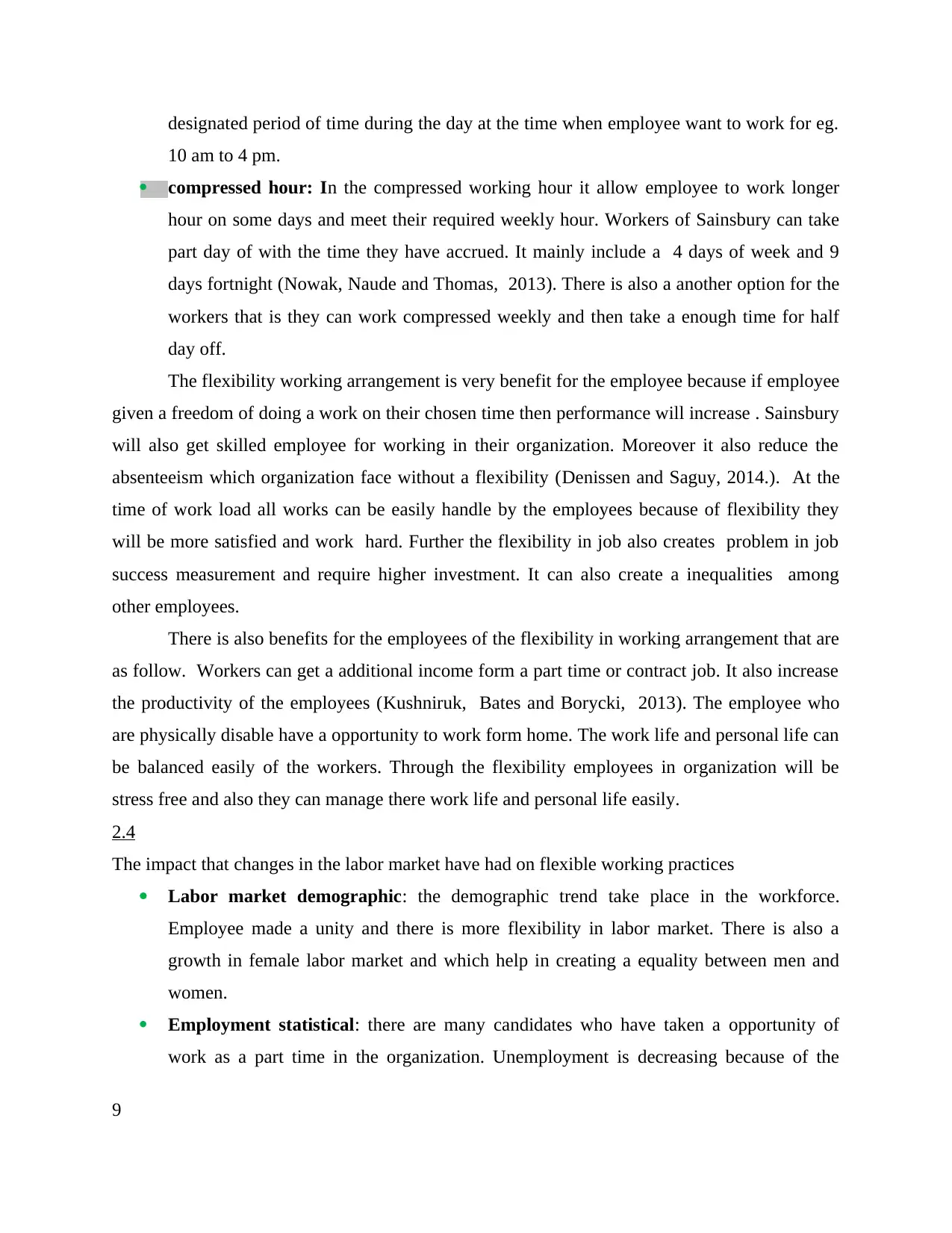
designated period of time during the day at the time when employee want to work for eg.
10 am to 4 pm.
compressed hour: In the compressed working hour it allow employee to work longer
hour on some days and meet their required weekly hour. Workers of Sainsbury can take
part day of with the time they have accrued. It mainly include a 4 days of week and 9
days fortnight (Nowak, Naude and Thomas, 2013). There is also a another option for the
workers that is they can work compressed weekly and then take a enough time for half
day off.
The flexibility working arrangement is very benefit for the employee because if employee
given a freedom of doing a work on their chosen time then performance will increase . Sainsbury
will also get skilled employee for working in their organization. Moreover it also reduce the
absenteeism which organization face without a flexibility (Denissen and Saguy, 2014.). At the
time of work load all works can be easily handle by the employees because of flexibility they
will be more satisfied and work hard. Further the flexibility in job also creates problem in job
success measurement and require higher investment. It can also create a inequalities among
other employees.
There is also benefits for the employees of the flexibility in working arrangement that are
as follow. Workers can get a additional income form a part time or contract job. It also increase
the productivity of the employees (Kushniruk, Bates and Borycki, 2013). The employee who
are physically disable have a opportunity to work form home. The work life and personal life can
be balanced easily of the workers. Through the flexibility employees in organization will be
stress free and also they can manage there work life and personal life easily.
2.4
The impact that changes in the labor market have had on flexible working practices
Labor market demographic: the demographic trend take place in the workforce.
Employee made a unity and there is more flexibility in labor market. There is also a
growth in female labor market and which help in creating a equality between men and
women.
Employment statistical: there are many candidates who have taken a opportunity of
work as a part time in the organization. Unemployment is decreasing because of the
9
10 am to 4 pm.
compressed hour: In the compressed working hour it allow employee to work longer
hour on some days and meet their required weekly hour. Workers of Sainsbury can take
part day of with the time they have accrued. It mainly include a 4 days of week and 9
days fortnight (Nowak, Naude and Thomas, 2013). There is also a another option for the
workers that is they can work compressed weekly and then take a enough time for half
day off.
The flexibility working arrangement is very benefit for the employee because if employee
given a freedom of doing a work on their chosen time then performance will increase . Sainsbury
will also get skilled employee for working in their organization. Moreover it also reduce the
absenteeism which organization face without a flexibility (Denissen and Saguy, 2014.). At the
time of work load all works can be easily handle by the employees because of flexibility they
will be more satisfied and work hard. Further the flexibility in job also creates problem in job
success measurement and require higher investment. It can also create a inequalities among
other employees.
There is also benefits for the employees of the flexibility in working arrangement that are
as follow. Workers can get a additional income form a part time or contract job. It also increase
the productivity of the employees (Kushniruk, Bates and Borycki, 2013). The employee who
are physically disable have a opportunity to work form home. The work life and personal life can
be balanced easily of the workers. Through the flexibility employees in organization will be
stress free and also they can manage there work life and personal life easily.
2.4
The impact that changes in the labor market have had on flexible working practices
Labor market demographic: the demographic trend take place in the workforce.
Employee made a unity and there is more flexibility in labor market. There is also a
growth in female labor market and which help in creating a equality between men and
women.
Employment statistical: there are many candidates who have taken a opportunity of
work as a part time in the organization. Unemployment is decreasing because of the
9
⊘ This is a preview!⊘
Do you want full access?
Subscribe today to unlock all pages.

Trusted by 1+ million students worldwide
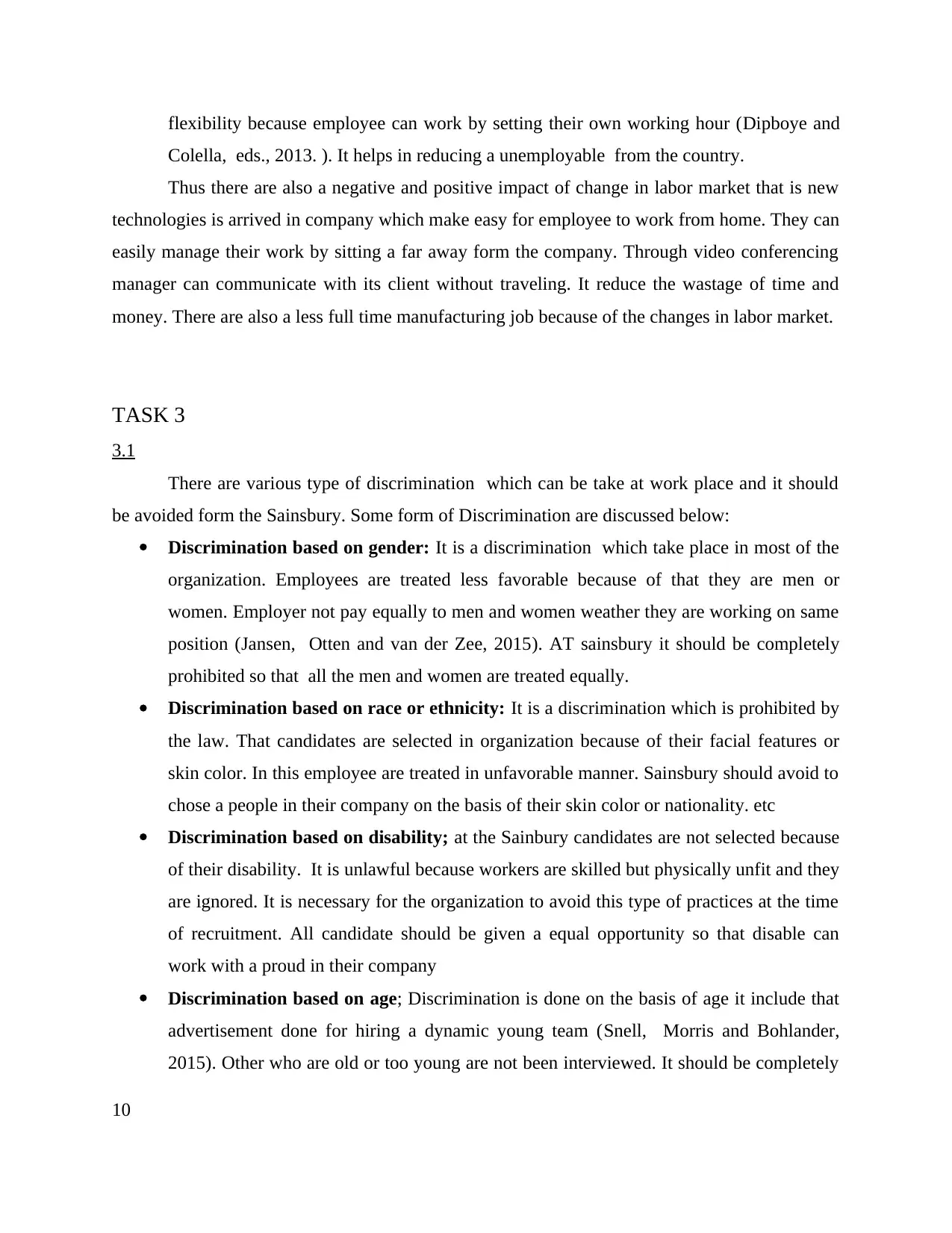
flexibility because employee can work by setting their own working hour (Dipboye and
Colella, eds., 2013. ). It helps in reducing a unemployable from the country.
Thus there are also a negative and positive impact of change in labor market that is new
technologies is arrived in company which make easy for employee to work from home. They can
easily manage their work by sitting a far away form the company. Through video conferencing
manager can communicate with its client without traveling. It reduce the wastage of time and
money. There are also a less full time manufacturing job because of the changes in labor market.
TASK 3
3.1
There are various type of discrimination which can be take at work place and it should
be avoided form the Sainsbury. Some form of Discrimination are discussed below:
Discrimination based on gender: It is a discrimination which take place in most of the
organization. Employees are treated less favorable because of that they are men or
women. Employer not pay equally to men and women weather they are working on same
position (Jansen, Otten and van der Zee, 2015). AT sainsbury it should be completely
prohibited so that all the men and women are treated equally.
Discrimination based on race or ethnicity: It is a discrimination which is prohibited by
the law. That candidates are selected in organization because of their facial features or
skin color. In this employee are treated in unfavorable manner. Sainsbury should avoid to
chose a people in their company on the basis of their skin color or nationality. etc
Discrimination based on disability; at the Sainbury candidates are not selected because
of their disability. It is unlawful because workers are skilled but physically unfit and they
are ignored. It is necessary for the organization to avoid this type of practices at the time
of recruitment. All candidate should be given a equal opportunity so that disable can
work with a proud in their company
Discrimination based on age; Discrimination is done on the basis of age it include that
advertisement done for hiring a dynamic young team (Snell, Morris and Bohlander,
2015). Other who are old or too young are not been interviewed. It should be completely
10
Colella, eds., 2013. ). It helps in reducing a unemployable from the country.
Thus there are also a negative and positive impact of change in labor market that is new
technologies is arrived in company which make easy for employee to work from home. They can
easily manage their work by sitting a far away form the company. Through video conferencing
manager can communicate with its client without traveling. It reduce the wastage of time and
money. There are also a less full time manufacturing job because of the changes in labor market.
TASK 3
3.1
There are various type of discrimination which can be take at work place and it should
be avoided form the Sainsbury. Some form of Discrimination are discussed below:
Discrimination based on gender: It is a discrimination which take place in most of the
organization. Employees are treated less favorable because of that they are men or
women. Employer not pay equally to men and women weather they are working on same
position (Jansen, Otten and van der Zee, 2015). AT sainsbury it should be completely
prohibited so that all the men and women are treated equally.
Discrimination based on race or ethnicity: It is a discrimination which is prohibited by
the law. That candidates are selected in organization because of their facial features or
skin color. In this employee are treated in unfavorable manner. Sainsbury should avoid to
chose a people in their company on the basis of their skin color or nationality. etc
Discrimination based on disability; at the Sainbury candidates are not selected because
of their disability. It is unlawful because workers are skilled but physically unfit and they
are ignored. It is necessary for the organization to avoid this type of practices at the time
of recruitment. All candidate should be given a equal opportunity so that disable can
work with a proud in their company
Discrimination based on age; Discrimination is done on the basis of age it include that
advertisement done for hiring a dynamic young team (Snell, Morris and Bohlander,
2015). Other who are old or too young are not been interviewed. It should be completely
10
Paraphrase This Document
Need a fresh take? Get an instant paraphrase of this document with our AI Paraphraser
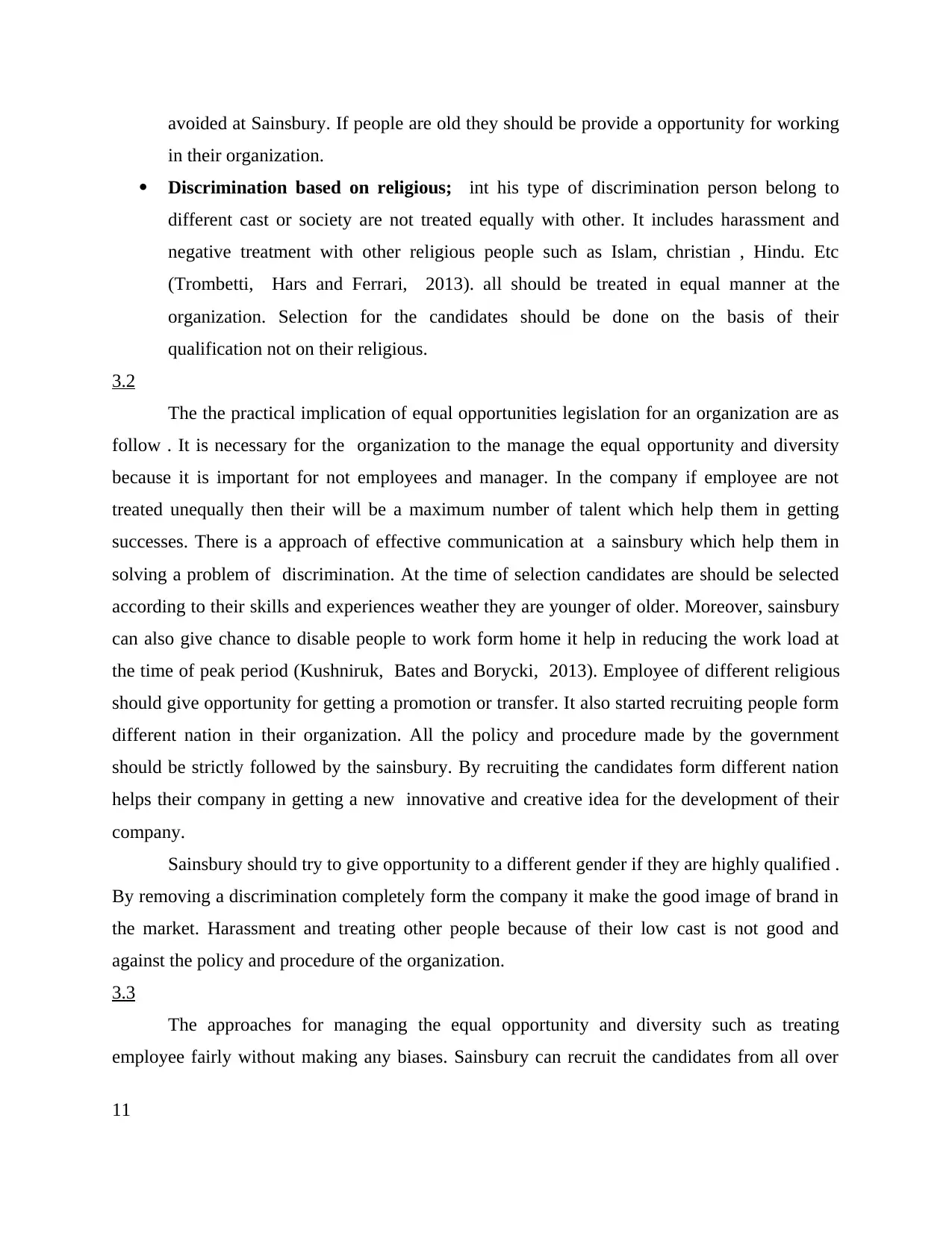
avoided at Sainsbury. If people are old they should be provide a opportunity for working
in their organization.
Discrimination based on religious; int his type of discrimination person belong to
different cast or society are not treated equally with other. It includes harassment and
negative treatment with other religious people such as Islam, christian , Hindu. Etc
(Trombetti, Hars and Ferrari, 2013). all should be treated in equal manner at the
organization. Selection for the candidates should be done on the basis of their
qualification not on their religious.
3.2
The the practical implication of equal opportunities legislation for an organization are as
follow . It is necessary for the organization to the manage the equal opportunity and diversity
because it is important for not employees and manager. In the company if employee are not
treated unequally then their will be a maximum number of talent which help them in getting
successes. There is a approach of effective communication at a sainsbury which help them in
solving a problem of discrimination. At the time of selection candidates are should be selected
according to their skills and experiences weather they are younger of older. Moreover, sainsbury
can also give chance to disable people to work form home it help in reducing the work load at
the time of peak period (Kushniruk, Bates and Borycki, 2013). Employee of different religious
should give opportunity for getting a promotion or transfer. It also started recruiting people form
different nation in their organization. All the policy and procedure made by the government
should be strictly followed by the sainsbury. By recruiting the candidates form different nation
helps their company in getting a new innovative and creative idea for the development of their
company.
Sainsbury should try to give opportunity to a different gender if they are highly qualified .
By removing a discrimination completely form the company it make the good image of brand in
the market. Harassment and treating other people because of their low cast is not good and
against the policy and procedure of the organization.
3.3
The approaches for managing the equal opportunity and diversity such as treating
employee fairly without making any biases. Sainsbury can recruit the candidates from all over
11
in their organization.
Discrimination based on religious; int his type of discrimination person belong to
different cast or society are not treated equally with other. It includes harassment and
negative treatment with other religious people such as Islam, christian , Hindu. Etc
(Trombetti, Hars and Ferrari, 2013). all should be treated in equal manner at the
organization. Selection for the candidates should be done on the basis of their
qualification not on their religious.
3.2
The the practical implication of equal opportunities legislation for an organization are as
follow . It is necessary for the organization to the manage the equal opportunity and diversity
because it is important for not employees and manager. In the company if employee are not
treated unequally then their will be a maximum number of talent which help them in getting
successes. There is a approach of effective communication at a sainsbury which help them in
solving a problem of discrimination. At the time of selection candidates are should be selected
according to their skills and experiences weather they are younger of older. Moreover, sainsbury
can also give chance to disable people to work form home it help in reducing the work load at
the time of peak period (Kushniruk, Bates and Borycki, 2013). Employee of different religious
should give opportunity for getting a promotion or transfer. It also started recruiting people form
different nation in their organization. All the policy and procedure made by the government
should be strictly followed by the sainsbury. By recruiting the candidates form different nation
helps their company in getting a new innovative and creative idea for the development of their
company.
Sainsbury should try to give opportunity to a different gender if they are highly qualified .
By removing a discrimination completely form the company it make the good image of brand in
the market. Harassment and treating other people because of their low cast is not good and
against the policy and procedure of the organization.
3.3
The approaches for managing the equal opportunity and diversity such as treating
employee fairly without making any biases. Sainsbury can recruit the candidates from all over
11
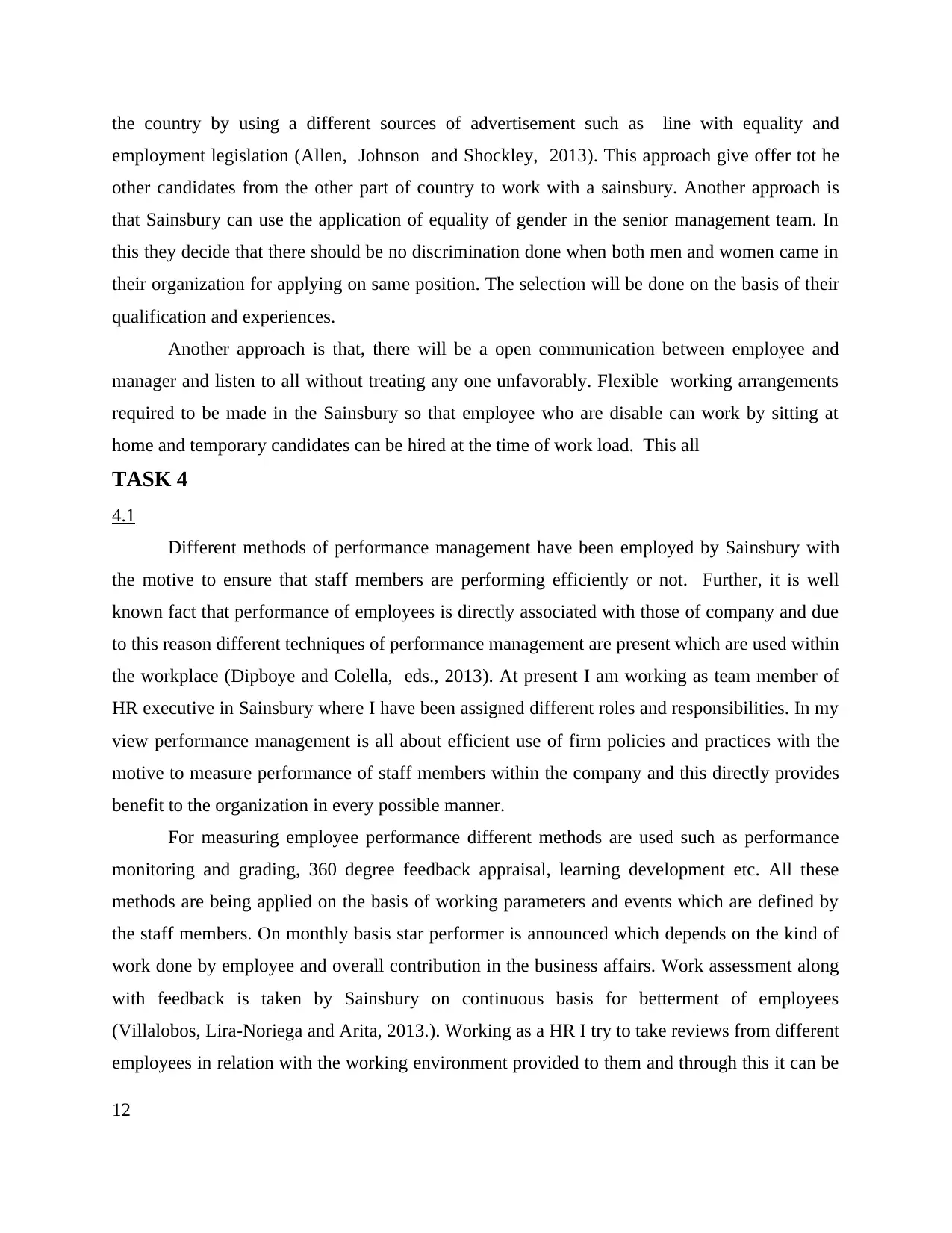
the country by using a different sources of advertisement such as line with equality and
employment legislation (Allen, Johnson and Shockley, 2013). This approach give offer tot he
other candidates from the other part of country to work with a sainsbury. Another approach is
that Sainsbury can use the application of equality of gender in the senior management team. In
this they decide that there should be no discrimination done when both men and women came in
their organization for applying on same position. The selection will be done on the basis of their
qualification and experiences.
Another approach is that, there will be a open communication between employee and
manager and listen to all without treating any one unfavorably. Flexible working arrangements
required to be made in the Sainsbury so that employee who are disable can work by sitting at
home and temporary candidates can be hired at the time of work load. This all
TASK 4
4.1
Different methods of performance management have been employed by Sainsbury with
the motive to ensure that staff members are performing efficiently or not. Further, it is well
known fact that performance of employees is directly associated with those of company and due
to this reason different techniques of performance management are present which are used within
the workplace (Dipboye and Colella, eds., 2013). At present I am working as team member of
HR executive in Sainsbury where I have been assigned different roles and responsibilities. In my
view performance management is all about efficient use of firm policies and practices with the
motive to measure performance of staff members within the company and this directly provides
benefit to the organization in every possible manner.
For measuring employee performance different methods are used such as performance
monitoring and grading, 360 degree feedback appraisal, learning development etc. All these
methods are being applied on the basis of working parameters and events which are defined by
the staff members. On monthly basis star performer is announced which depends on the kind of
work done by employee and overall contribution in the business affairs. Work assessment along
with feedback is taken by Sainsbury on continuous basis for betterment of employees
(Villalobos, Lira-Noriega and Arita, 2013.). Working as a HR I try to take reviews from different
employees in relation with the working environment provided to them and through this it can be
12
employment legislation (Allen, Johnson and Shockley, 2013). This approach give offer tot he
other candidates from the other part of country to work with a sainsbury. Another approach is
that Sainsbury can use the application of equality of gender in the senior management team. In
this they decide that there should be no discrimination done when both men and women came in
their organization for applying on same position. The selection will be done on the basis of their
qualification and experiences.
Another approach is that, there will be a open communication between employee and
manager and listen to all without treating any one unfavorably. Flexible working arrangements
required to be made in the Sainsbury so that employee who are disable can work by sitting at
home and temporary candidates can be hired at the time of work load. This all
TASK 4
4.1
Different methods of performance management have been employed by Sainsbury with
the motive to ensure that staff members are performing efficiently or not. Further, it is well
known fact that performance of employees is directly associated with those of company and due
to this reason different techniques of performance management are present which are used within
the workplace (Dipboye and Colella, eds., 2013). At present I am working as team member of
HR executive in Sainsbury where I have been assigned different roles and responsibilities. In my
view performance management is all about efficient use of firm policies and practices with the
motive to measure performance of staff members within the company and this directly provides
benefit to the organization in every possible manner.
For measuring employee performance different methods are used such as performance
monitoring and grading, 360 degree feedback appraisal, learning development etc. All these
methods are being applied on the basis of working parameters and events which are defined by
the staff members. On monthly basis star performer is announced which depends on the kind of
work done by employee and overall contribution in the business affairs. Work assessment along
with feedback is taken by Sainsbury on continuous basis for betterment of employees
(Villalobos, Lira-Noriega and Arita, 2013.). Working as a HR I try to take reviews from different
employees in relation with the working environment provided to them and through this it can be
12
⊘ This is a preview!⊘
Do you want full access?
Subscribe today to unlock all pages.

Trusted by 1+ million students worldwide
1 out of 18
Related Documents
Your All-in-One AI-Powered Toolkit for Academic Success.
+13062052269
info@desklib.com
Available 24*7 on WhatsApp / Email
![[object Object]](/_next/static/media/star-bottom.7253800d.svg)
Unlock your academic potential
Copyright © 2020–2025 A2Z Services. All Rights Reserved. Developed and managed by ZUCOL.





